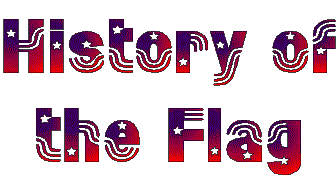
The Flag of the United States of America is one of the oldest of the national standards of the world; older than the Union Jack of Great Britain or the Tricolor of France.
During the early days of the Revolutionary War a variety of flags were used by the different colonies and military commands. Prominent among these were the "Pine Tree" and "Rattlesnake" flags with various arrangements and mottoes.
Late in 1775 a committee of Congress with Benjamin Franklin at the head, after consulting with Washington, then in command of the army at Cambridge, decided upon the form of a new flag. This flag consisted of thirteen stripes red and white, with the cross of St. George and St. Andrew on a blue field in the canton or union. This preceded the Declaration of Independence and indicated that the colonies had not wholly broken from the mother country. This flag was first unfurled by Washington, January 2, 1776. It was probably this flag which was raised by Paul Jones on his vessel and carried by the American fleet which sailed out of Philadelphia in February 1776.
During 1776 and 1777 a number of flags with thirteen stripes came into use and the need of a definite national emblem was realized. On June 14, 1777, Congress passed an act stating "That the Flag of the thirteen United States be thirteen stripes, alternating red and white, that the union be thirteen stars, white in a blue field, representing a new constellation." This is the birthday of the Flag as we now know it and June 14 is now celebrated as "Flag Day." This new flag was probably first displayed on land during the Battle at Fort Stanwix, New York, although there are a number of authorities who claim that the first Stars and Stripes displayed in battle was at the Battle of Bennington, Vermont, August 16th, 1777. At any rate, this flag, as displayed, remained the national standard until 1795. The first display of the Stars and Stripes by the Continental Army was when the Flag was hoisted over Fort Stanwix, New York, on August 3, 1777.
In the meantime Vermont and Kentucky had become states, and on January 13, 1794, Congress voted that the Flag should have fifteen stripes and fifteen stars. This Flag remained in use for twenty-three years, and it was "The Star Spangled Banner" of which Francis Scott Key wrote in 1814.
In April 1818, Congress passed an act providing that the Flag should have thirteen horizontal stripes, alternating red and white, and that the union should display twenty stars, representing the number of states in the Union. It also provided that on the admission of every new state to the Union a star should be added on the following July 4th and this has been the regulation ever since, accounting for the number of stars now shown.









 E-Mail
E-Mail